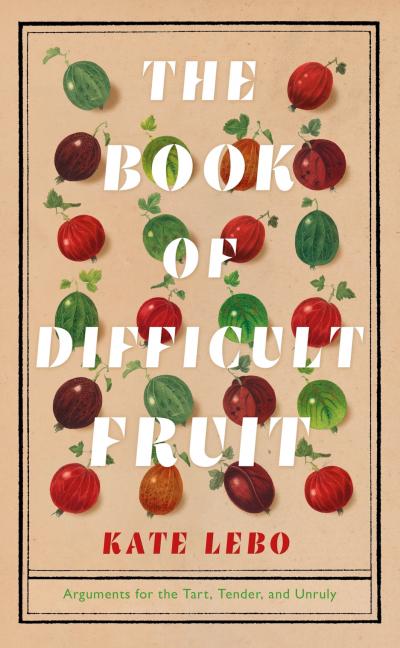Two years ago, I became preoccupied with beetroot. I didn’t want to eat it, particularly, or learn new ways to cook this crimson-purple veg. Instead I hunted down stories of the “beet-rave”, as it was once called (from the French la betterave), from an earlier time when rave was a root vegetable, and a “wild rave”, instead of a techno-fuelled, all-night dance party, was a horseradish. In his novel Jitterbug Perfume (1984), Tom Robbins describes the beetroot as “the most intense of vegetables”, a “deadly serious” root whose leaking liquid resembles blood. It was Rasputin’s favourite, he conjectures: “You could see it in his eyes.” A murderous vegetable, the beta vulgaris has been collected and consumed at least since the Neolithic period; it is descended from a leathery green perennial that dotted the coastlines of Europe, northern Africa and southern Asia.
In The Book of Difficult Fruit: Arguments for the Tart, Tender, and Unruly, a hybrid collection of essays and recipes, Kate Lebo presents her own series of edible preoccupations: 26 difficult fruits, ranging from aronia berries (or “chokeberries”) to “sensationally stinky” durian fruit, kiwis (the “Chinese gooseberry” rebranded) to medlars (a “shrivelled, rosehiplike bulb” which isn’t ripe until it’s rotten), and the inedible Osange orange to the growth-hungry zucchini. All of them hold some personal resonance for their author, a closeness reinforced by her time spent handling and consuming them: “No matter how deeply I researched difficult fruits, the most essential information came when I gathered, cooked, and ate them”. The collection contains recipes as well as essays, mixing memoir with cultural history. The histories of these fruits always lead to broader topics, an unpacking of the complex relationship between food and medicine, eating and pleasure, pain and care.
 Lebo is a poet as well as a pie-maker. Her previous books include the anthology Pie & Whiskey: Writers Under the Influence of Butter and Booze, cookbook Pie School: Lessons in Fruit, Flour & Butter (both Sasquatch Books) and A Commonplace Book of Pie (Chin Music Press), which combined poetry, ephemera and recipes. In this collection, which might seem like an encyclopaedia (a book which orders and itemises), categories are loose and intuitive rather than neat and fixed. “Each fruit in this book is difficult in its own way,” she writes in the introduction: “Some are impossible to domesticate or tough to prepare. Some can be medicine or poison, depending on the size of the dose.” And some of them are not even fruit: sugarcane, rhubarb, wheat, and xylitol (a sugar alcohol created by plants and animals).
Lebo is a poet as well as a pie-maker. Her previous books include the anthology Pie & Whiskey: Writers Under the Influence of Butter and Booze, cookbook Pie School: Lessons in Fruit, Flour & Butter (both Sasquatch Books) and A Commonplace Book of Pie (Chin Music Press), which combined poetry, ephemera and recipes. In this collection, which might seem like an encyclopaedia (a book which orders and itemises), categories are loose and intuitive rather than neat and fixed. “Each fruit in this book is difficult in its own way,” she writes in the introduction: “Some are impossible to domesticate or tough to prepare. Some can be medicine or poison, depending on the size of the dose.” And some of them are not even fruit: sugarcane, rhubarb, wheat, and xylitol (a sugar alcohol created by plants and animals).
Still, shared among them is a wayward tendency: an inner resistance, wildness or demand for exertion. Fruit here is not “a symbol of goodness and kindness and productivity”. It is instead that which is laboured into being: “‘Fruit of the womb, we say. Or ‘fruits of my labor.’ What precedes the bounty contained by these clichés – the thing obscured but not erased by the feast […] is pain.” Fruit may be “tender”, where that adjective describes a yielding softness, but it’s also a state that bears the imprint of an injury. Anxiety wired into the body’s muscles and joints: “Remember to breathe, the women say. Remember to eat, the men say.” “What if love is, on some level, an exchange of medicines?” she asks, casting human relationships as a constant negotiation between health and sickness. "F" is for faceclock (a charmingly folksy name for a dandelion, also known as a puffball, a cankerwort, or a milk witch) which leads Lebo to discuss weeding, which she uses as an antidote to depression (or Frühjahrsmüdigkeit: “spring fatigue”). "L" is for lump, as in the cancer prevalent in her family and diagnosed in her college friend. "W" is for wheat, which centres on an ex who had coeliac disease, transforming the flour of Lebo’s baking into a poison, and their relationship into a fraught battleground caught between love and fear.
The book as a whole is concerned with the entanglement of “nurtures” and “harms” within our eating habits. On the one hand, it is evident how diet, and the repetitions that surround eating, can provide us with comfort and wellness: “the ritual of taking care of ourselves, helps improve our wellbeing.” On the other, food might become a trap or a barrier to connection. Of her mother, who suffers from excruciating migraines, she writes: “Sometimes I think she’s trying to cure herself with diets because diets are impossible to follow perfectly, so when she slips up she can rest the blame of her illness on herself.” Meanwhile, “refusing to eat the same food, even for the sake of her health, frays her bond with us.”
Apparently familiar fruits also hold hidden dangers. The pits of cherries, plums, and peaches all contain amygdalin, which reacts in the stomach to form cyanide. The leaves of rhubarb are sour and should not be eaten: they can “cause gastrointestinal distress and even death, and in small regular doses, they assist the body’s formation of kidney stones”. Juniper berries, which give gin its distinctive taste, contain “terpene-rich oils that thin blood, regulate menses and in higher quantities cause miscarriages” – hence gin’s English nickname, “Mother’s Ruin”. A difficult fruit may be a deadly fruit; food might be a cause of pain and sickness as much as it might also be a remedy. Nature here is not mistaken for its anodyne, sentimental imaginary.
It’s in this way that Lebo carves out a thrillingly new, melancholy kind of food writing, which is alert to the postures of the food writer and less certain about the characteristic “knowing voice” and “imperative mood”. Her book is lyrical, wise, and crammed with knowledge, but it is also unafraid to stray into the spaces of hesitant reflection; the logic is associative, even as the traditional hallmarks of good food writing – the precise rendering of smell, taste and texture – also prevail. (Durian is “like peaches laced with onions and garbage”. Elderberry is inescapably tart, even when doused with sugar: “something chemical remains, some twinge where my tongue attaches to my mouth. A pinch in that soft part, like a warning.”)
I learned so much from this book: not just about fruit, but about pain, care and relationships. I recommend it warmly, could rave about it, even. It’s a rich, juicy delight.
- The Book of Difficult Fruit: Arguments for the Tart, Tender, and Unruly by Kate Lebo (Pan Macmillan, £14.99)
- Read more book reviews on theartsdesk















Add comment